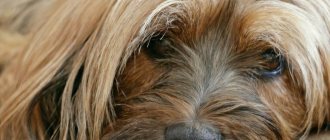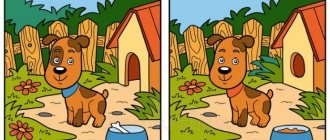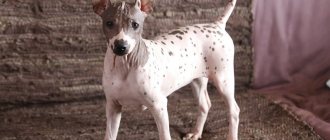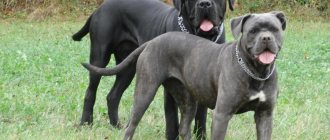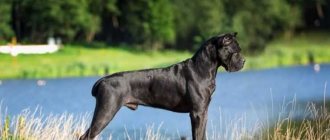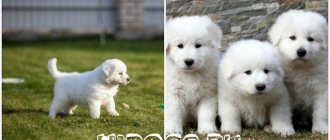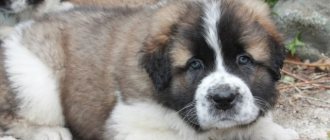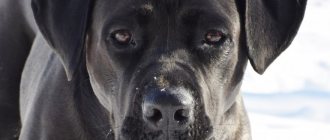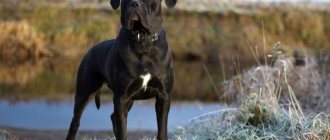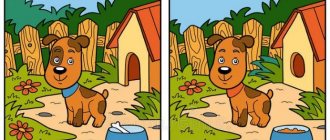When getting a dog, many people would like to know if it can act as a protector. Of course, the main indicator in this case is the dog’s readiness to fight. But don’t forget about physical fighting qualities. For example, many animal lovers are interested in which dog has the strongest bite. It depends on how hard she can bite her ill-wisher and whether she will injure him. Therefore, it will be useful to talk about this parameter.
A very impressive argument
Anatomy of a bite
In fact, the bite force of dogs of different breeds depends on two parameters: the length of the jaws and the power of the chewing muscles. Of course, the more powerful the muscles, the stronger the bite. On the other hand, in many dogs with a short muzzle the bite is not as strong, but the area of pressure is smaller. This ensures the so-called death grip.
A dog with a death grip does not necessarily have to be big and scary, like, for example, a Caucasian Shepherd. After all, a small French bulldog, thanks to its small jaw area, is capable of inflicting an equally terrible bite.
Fact! The pressure of the molars is approximately 15-20% greater than the pressure of the incisors. For objectivity, the average value is taken.
Not with just teeth
Which dog bites the hardest? The one that really wants to bite. It looks like a joke, but only partly. The strongest jaws in dogs are not a guarantee that they will be used. There are breeds in which aggression is genetically absent - Labrador, Golden Retriever. Although they are not inferior in strength and weight to the German Shepherd, these dogs are not capable of attacking humans.
Among representatives of guard breeds, it is rare, but still there are good-natured specimens that do a poor job of protecting their owner or property. In this case, the problem lies in education; under the guidance of an experienced dog handler, it is possible to awaken the inherent potential in a Rottweiler or black terrier.
How is jaw strength measured in dogs, why know this parameter
The bite force of a bull terrier or other dog cannot be measured at home - this requires special equipment, which is available to specialists. First, they have to anger the dog so that it can bite the proposed armband with a sensor as hard as possible. The bite indicator is immediately displayed on the screen.
Why do you need to know this parameter at all? This is important for owners of fighting and service dogs - if the dog has an insufficiently powerful bite, this is a serious defect - it will not be able to effectively perform its function.
Dutch Shepherd
A service dog breed that is suitable for guarding and protection, as a companion and personal bodyguard. Another name for the breed is Herder. The Dutch Shepherd can be briefly described in a few words: smart, easy to train, balanced, hardy and loyal. Today this breed is used by the police and other security agencies. This is all thanks to its powerful jaws and outstanding intelligence compared to other breeds. Their jaws are very powerful and their bites can cause serious injury.
The Dutch Shepherd is a strong dog, proportional in build, medium in size, slightly elongated. Height at withers - from 57 to 62 cm. Weight ranges from 30-40 kg. She is calm, affectionate with children, strongly attached to all family members, but selflessly devoted to only one person - her owner.
Rating of dogs with the strongest grip
Now it’s time to talk about such an important indicator as the clenching force of dogs’ jaws - a table by breed will allow you to form the most objective opinion about a particular animal.
The German Shepherd is one of the leaders
German Shepherd
Of course, if we talk about dogs with the strongest bite, then we should definitely mention the German Shepherd. This dog is distinguished not only by its intelligence and discipline, but also by its powerful jaws.
In young dogs at the age of two years, this figure is about 1030 Newton, and in more mature dogs (3-5 years old) it even reaches 1310 N - simply an excellent parameter.
American Staffordshire Terrier
One of the undisputed leaders of dog fighting is the world famous Stafford. His indicator is almost as good as that of a shepherd dog - about 1250 N. At the same time, they are trained to work “to break away,” that is, often the dog not only grabs the enemy’s flesh, but also jerks sharply, thanks to which it inflicts simply terrible wounds.
Dutch Shepherd
But the Dutch Shepherd confidently outperforms both the Amstaff and its German relative - in this dog this figure reaches 1570 N! It is not surprising that in its homeland this dog is actively used by the military and police. A powerful bite combined with excellent discipline make her a reliable assistant.
Boxer
With a diminutive face, the Boxer may seem like a less impressive dog than those listed above. However, this is a dog with a death grip - it is precisely because of the short jaws that it is almost impossible to release such a grip.
And the compression force is not the smallest - about 1580 Newton, which is a very impressive figure.
American Bandog
American Bandog in all its glory
The result of crossing a pit bull and a Neapolitan mastiff gave a very good result.
Even in young dogs, the bite force is about 1200 N, and in adults and trained dogs it reaches 1450 N, which is a very good indicator. So, this breed is definitely included in the TOP.
Bull Terrier
Of course, when talking about such an indicator as bite force, one cannot fail to mention this dog - one of the leaders among fighters and, perhaps, the most dangerous of all dog breeds. These are not just words - the Bull Terrier has a jaw clenching force of approximately 1100 Newtons. And this conversation is about a young, untrained dog.
If you spend enough time and effort on preparation, it is quite possible to increase this figure to 1400 N. It will easily crush even thick bones!
Remember! Fighting dogs are often trained by forcing them to cling to a thick stick and hanging them in this state - they are able to hang for a long time, holding on only with their teeth.
Doberman
But this is a rather difficult dog to raise and maintain. In general, when starting her up, you always need to keep your ears open. Moreover, the point is not only in rather high aggression and partial inadequacy (alas, this occurs in some representatives of the breed), but also in very powerful jaws.
For this breed, the figure is about 1580 N - even more than many fighting breeds.
Rottweiler
Overall, he is a smart, confident dog. But this does not prevent him from remaining a most dangerous opponent for both dogs and people, whom the Rottweiler often views in a similar capacity.
Its jaws are very powerful - they provide a force of approximately 1500 N. To this should also be added a special shape of the teeth and a scissor-shaped bite - this makes it possible to easily bite out pieces of flesh from the victim.
English Mastiff
Representatives of this breed amazingly combine a strong bite and a friendly character. By leaving such a pet with the baby, the owner can be sure that the latter is in no danger at all. The mighty dog would never harm his master’s “puppy” and, if necessary, would die protecting him. And this is a compelling argument - after all, the pressure force of the jaws reaches almost 1300 N.
Caucasian Shepherd Dog
He can bite a human leg.
But this is a truly terrible opponent. Moreover, we are talking not only about the harsh disposition and huge dimensions. It is almost impossible to escape from the jaws of the Caucasian Shepherd. Of course, the area of pressure here is quite large, but the power of the jaws will also unpleasantly surprise anyone who gets in this dog’s teeth.
The pressure here reaches 1300 N. Of course, when angry, such a dog can literally crush the thick tibia bone, not to mention the torn muscles. It is better not to fight such an enemy in a duel.
Bullmastiff
Another breed that could become the worst participant in dog fighting, if not for its relatively peaceful nature. But still, he is not afraid of fights and, if necessary, confidently enters the fray. Moreover, the tactics of bullmastiffs are practically win-win - he only needs to knock the enemy down, fall on him and inflict one bite - he probably won’t need more.
Attention! The pressure force reaches 1650 Newton, which is perhaps the best indicator among dogs.
And if you consider that bullmastiffs usually choose the stomach or throat of the victim to attack, it becomes clear why very few experts are willing to pit their pets against these machines for killing and dismemberment.
Pitbull
The ranking of dogs with the most powerful jaws is completed by another dog fighting record holder. His indicator is 1350 N. Even more than that of the American Stafford. And to this it is also worth adding the fact that in a fight, especially at the sight of blood, the pit bull literally “blows the tower down.” He becomes almost uncontrollable - he tears everything he can reach, while practically feeling no pain.
This is what makes him such a terrible opponent - there is only one way to stop him - by finishing off the four-legged demon in dog form.
Golden mean
Knowing the aspects that influence the bite, you can understand that the strongest jaws are in dogs of those breeds that have a fairly large head with a wide opening of the jaws. In addition, the guard must have a sufficient level of aggression and courage to use his formidable weapon in battle. It was this rule that guided people when they bred protective guard breeds to protect people and their property. In addition, guard dogs must have a calm disposition, be easy to train, and be devoted to the owner’s family. An overly excitable dog does not respond well to commands and can turn from a protector into a source of problems.
How to properly care
Bull terriers can live in an apartment without any problems, the main thing is the presence of the owner nearby and regular active walks . Moreover, these dogs are very heat-loving, and their short coat makes them unsuitable for outdoor living.
Wool and bathing
Bull Terriers should be brushed no more than 3 times a week using a stiff brush made of natural bristles - this improves blood circulation and gets rid of dust and minor dirt..
During seasonal shedding, you need to comb your pet daily with a special grooming glove.
Representatives of this breed must be bathed as they become dirty, maximum once a quarter, using a special mild shampoo for dogs.
To avoid the appearance of plaque and tartar, you need to brush your pet’s teeth once a week with a special brush and toothpaste for dogs.
Eyes
Every morning, wipe with a cotton pad soaked in a special lotion or boiled water.
Claws
As a rule, the nails of adult dogs wear down on their own during walks . If this does not happen, they need to be trimmed every 3-4 weeks with a guillotine nail clipper so as not to touch the blood vessels.
Clean the inside of your ear weekly with a damp cotton pad. Do not use cotton swabs - any careless movement can lead to hearing loss for your pet.
Pitbull
This is a medium-sized dog, strong built with well-defined muscles. This breed is characterized by athleticism. Pit bulls are distinguished by their large muscle mass and strong build. Looking at this dog, you can understand that this is a freedom-loving, strong and tireless dog. The pit bull inherited his will and fighting qualities from the bulldog. And the terrier rewarded him with a quick reaction.
Adult animals weigh on average about 25 kg. Its height at the withers reaches 50 cm. The pit bull’s character is strong-willed, and is characterized by increased gambling and a strong fighting spirit. The Pit Bull Terrier feels good in an ordinary city apartment. But at the same time, he simply needs regular sports walks and communication with his relatives.
The jaw strength of a pit bull is simply monstrous. They grab their prey and do not let go under any circumstances. The owner has to use sticks and other improvised means to open the closed jaws, but this does not always work.
Character traits
There is a firmly entrenched stereotype in society that bull terriers are angry, unbalanced dogs prone to aggressive behavior.
However, despite their fighting past, they are cheerful, affectionate, playful and friendly animals, distinguished by their devotion and ability to find a common language with all family members.
Representatives of this breed are not characterized by aggression towards people . Such behavior has always been considered a serious fault and individuals in which it was observed were rejected.
Bull Terriers are smart and quick-witted dogs . They are highly trainable, but can sometimes be stubborn. Therefore, it is important to raise your pet correctly from an early age.
These dogs do not tolerate loneliness well. Out of boredom and idleness, he begins to look for a way out of his irrepressible energy through damage to property.
They need physical activity, regular active walks, including elements of training, running and other activities that allow them to get rid of energy and stay fit.
Bull Terriers will be excellent pets for active people who love sports and enjoy running . The owner of a bull terrier must be an experienced dog breeder with strong nerves, leadership qualities, patience and perseverance.
Color variations
In accordance with the breed standard, the skin pigmentation of bull terriers does not matter, and their coat can be:
- white - the most common color in which the coat is solid white, but markings of any color on the head are also acceptable;
- red - a coat of solid red color of any shade without spots or marks;
- black - as a rule, such dogs have small patches of white on their bodies, therefore, despite the predominance of black, the color is classified as bicolor;
- two-color - the wool is painted white and some other color;
- tricolor - coat of white, black and red (brown) colors;
- brindle - red fur with dark stripes, or vice versa, if there are white markings on the face, the color is called brindle-white.
Gray, fawn, blue bull terriers, as well as individuals with a white coat, whose colored spots are not located on the head, are not allowed for breeding.
Is he good with children and does he get along with other pets?
Bull Terriers at home get along well with children, becoming excellent nannies for them. These dogs are patient and loyal to children's pranks.
Being cheerful and carefree animals, they quickly find a common language with kids and play with them with pleasure..
At the same time, it is better to get a puppy when there is already a baby in the family - this will help to avoid jealousy on the part of the dog and its attempts to regain the undivided attention of its owners.
IMPORTANT!
At first, communication between the dog and the child must be controlled - the child’s unceremonious behavior can provoke an inadequate reaction from the bull terrier.
Bull Terriers are fighting dogs, the desire to win and be leaders is genetically embedded in them.
Therefore, they cannot stand the competition that other pets create, and the natural instincts of these dogs sooner or later take over. When they see cats, bull terriers lose control and become uncontrollable; dogs see them only as objects of hunting.
Types and their description
There are 3 types of bull terriers allocated by the FCI:
- English - fast and energetic dogs with a white coat, bred as a result of mating of a bulldog, terrier and Dalmatian;
- Staffordshire - energetic but slow animals that have significant exterior differences from English bulls; the coat can be brindle, black, red and white, brown, red and other colors;
- dwarf - a miniature copy of the English bull terrier with a coat of tri-color, white or yellow-brown color.
All these breeds are independent and only partly related to each other.
Origin history and interesting facts
Bull Terriers are the result of the work of English breeders . After the ban on bullfighting was introduced in 1835, people began to need powerful, strong, fearless and hardy fighting dogs.
Bulldogs were too clumsy, so it was decided to breed new, more compact, agile and agile dogs with the strength and ferocity of bulldogs.
To achieve this, Old English Bulldogs were crossed with Terriers. This is how a new breed appeared - bull and terriers.
Since 1850, D. Hinks began improving the new breed, whose goal was to improve its exterior . To do this, he crossed Bull and Terriers with white Old English Terriers, Bulldogs, Greyhounds, Dalmatians and Scottish Collies.
The breeder presented the result of his work in 1862 at an exhibition in Birmingham - the snow-white dog had not only the best fighting qualities, but also an aristocratic appearance. To avoid confusion, Hinks named the new breed the Bull Terrier.
The new dogs captivated the British and soon became popular all over the world . In 1885, bull terriers were recognized by the American canine organization, and in 1898, a club of fans of this breed was created in the United States.
Nutritional Features
The Bull Terrier's diet can be based on industrial feed or natural products.
Each owner independently determines what the dog’s nutrition will be; the main thing is not to mix both types of feeding and ensure that the diet is balanced, nutritious and includes all the necessary vitamins, macro- and microelements.
Natural nutrition allows the owner to independently control the quality of food consumed by the pet and diversify the diet as much as possible.
With this type of feeding, the menu must include:
- lean meat;
- chicken or beef by-products;
- boiled sea fish;
- seasonal vegetables and fruits, herbs;
- raw eggs;
- vegetable oils;
- dairy products;
- cereals
You can give your pet hard cheese as a treat.
It is necessary to additionally give the bull terrier a vitamin complex, and up to 18 months - calcium.
Representatives of this breed are prohibited:
- fat meat;
- smoked meats, pickles, marinades;
- sweets, chocolate;
- seasonings;
- River fish;
- spicy and fried foods;
- bakery and pasta products;
- legumes
If the diet is based on ready-made food, it must correspond to the age, physiological state and health of the pet.
You should not skimp on feeding your bull terrier and purchase economy class food - these dogs are suitable for products of at least premium class.
The most suitable brands of food for representatives of this breed are Orijen, AATU, Applaws, Acana, Bozita, Solid, Genesis, GO!, Grandorf.
